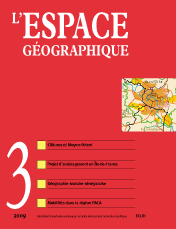

The challenge of “teichopolitics”, analysing the contemporary closure of territories (4 fig., 2 photos)
Common sense would suggest that globalisation signifies the end of walls. In fact, new systems of fenced boundaries are being built all over the world, and walls are even proliferating within cities. This paper seeks to analyse “teichopolitics” a new word derived from Ancient Greek teichos meaning “city wall” i.e. the politics of building walls. Security issues seem to be an obvious factor, but economic aspects are also important. Building walls is a source of profit for the security and construction industries. Developers and large companies, as well as governments and individuals, therefore have their own strategies that are contributing to the proliferation of barriers.
keywords: BARRIER, BOUNDARY, DEVELOPER, GATED COMMUNITY, GLOBALISATION, TEICHOPOLITIC, WALL
The paradigm of closure in Israel-Palestine
The “separation fence”, under construction since 2002, is often considered to represent a dramatic break with previous territorial management systems in the Middle East. However, over the 20th century, other models of closure developed that may have indirectly influenced the separation fence. Although designed on different scales, they might contribute to the same paradigm of spatial closure, which alternately expresses social, religious or security concerns. The article explores forms of spatial closure on various scales the block, the village, the city, the settlement and the gated community within the Israeli-Palestinian space.
keywords: BORDER, FENCE, FRAGMENTATION, GATED COMMUNITY, SEGREGATION
The impact of the geopolitical situation on how the populations of Hebron-al-Khalil (West Bank) inhabit the city (2 fig., 2 photos)
Since January 1997, the city of Hebron has been officially divided into two sectors: H1 the Palestinian sector where 100,000 Palestinians live, and H2 under Israeli sovereignty where 30,000 Palestinians and 700 settlers live. On the ground, this fragmentation translates into the creation of actual physical borders (with walls, checkpoints, etc.), even in the city centre. This article attempts to see how, in this city emblematic of the Israeli- Palestinian conflict, this unique situation where two groups of opposing representations co-exist influences the way in which the actors practice the space.
keywords: HEBRON, ISRAELI-PALESTINIAN CONFLICT, PRACTICE OF SPACE, TERRITORIAL IDEOLOGY
Shortly after independence, school geography was used in Senegal to meet the demands of nationbuilding. That was not an unprecedented role, since nation-building was a key function of the model that produced this geography and to which it refers. However, African revival introduced a new dimension, fuelled by various identity polarities. School geography was therefore used in a unique way, with teaching material invented to create a new man: an African whose African culture and national history, groundnut monocrop and openness to other cultures defined him as Senegalese.
keywords: EDUCATION, IDENTITY, POST-COLONIAL, SCHOOL GEOGRAPHY, SENEGAL
What kind of project of national interest is best suited to the Saclay plateau? (1 encadré, 3 fig.)
Although occupying an area of a mere 5,000 hectares, the Saclay plateau has inspired successive French governments with the grandest ambitions for several decades. The current government would like to establish an internationally recognised cluster campus on the site. Will this government’s determination finally see a project through? Drawing on the expertise of 120 actors, this paper shows that the high-tech idea is too narrow in comparison with the site’s potential and complexity, which could support a more ambitious project.
keywords: COMMON HERITAGE, PROJECT OF NATIONAL INTEREST, SACLAY PLATEAU, TERRITORY
Potential mobility and emergence of reticular structures in the Provence Alpes Côte d’Azur region (1 encadré, 5 fig., 2 tabl.)
Urban growth and increasing mobility flows are giving rise to new metropolitan areas structured as networks of cities. The metropolitan transformation of whole regions cannot be understood without taking into account the networking process. In order to explore the impact of mobility networks on the emergence of reticular metropolitan areas, potential mobility in the ProvenceAlpesCôtes d’Azur (PACA) region in south-eastern France is analysed. Potential mobility flows are deduced from a road network model of the study area. Several parameters are explored, including the size of potential urban hubs and maximum time-distance interactions.
keywords: FRANCE, METROPOLISATION, PROVENCE ALPES CÔTE D’AZUR REGION, POTENTIAL MOBILITY, URBAN NETWORK
Book reviews
In this issue of l’Espace géographique, you will find critical reviews of the following books
BA A.H. (2007). Acteurs et territoires du Sahel. Lyon: ENS Éditions, coll. «Sociétés, espaces, temps», 260 p. (Benoît ANTHEAUME, IRD Paris)
BENOÎT M., DEFFONTAINES J.-P., LARDON S. (2006). Acteurs et territoires locaux: vers une géoagronomie de l’aménagement. Versailles: INRA Éditions, coll. «Savoir faire», 174 p. (Yves POINSOT, université de Pau)
BOUTEFEU E. (2005). La Demande sociale de nature en ville. Enquête auprès des habitants de l’agglomération lyonnaise. La Défense: CERTU, Plan urbanisme construction architecture, 81 p. (Bernard DEBARBIEUX, université de Genève)
CAVAILHÈS J., JOLY D. (2006). Les Paysages périurbains et leur prix ville. Besançon: Presses universitaires de Franche-Comté, 201 p. (Bernard DEBARBIEUX, université de Genève)
CHAPUIS R. (2007). Vers des campagnes citadines, le Doubs (1975-2005). Besançon: Éditions Cêtre, Presses universitaires de Franche-Comté, 206 p. (Bernard DEBARBIEUX, université de Genève)
GALLOIS L. (2005). Régions naturelles et noms de pays: étude sur la région parisienne (avec la préface de Marie-Vic Ozouf-Marignier et Marie-Claire Robic). Paris: Éditions du CTHS, 381 p. (François WALTER, université de Genève)
LE CARO Y. (2007). Les Loisirs en espace agricole. L’expérience d’un espace partagé. Rennes: Presses universitaires de Rennes, 431 p. (Bernard DEBARBIEUX, université de Genève)
SUBRA P. (2007). Géopolitique de l’aménagement du territoire. Paris: Armand Colin, 327 p. (Yves GUERMOND, université Rouen)
L’espace géographique 2/09![]()
![]() L’espace géographique 4/09
L’espace géographique 4/09
For subscribe or buy this issue: BELIN
![]() L’Espace géographique: contents
L’Espace géographique: contents
Last modified: July 7, 2009